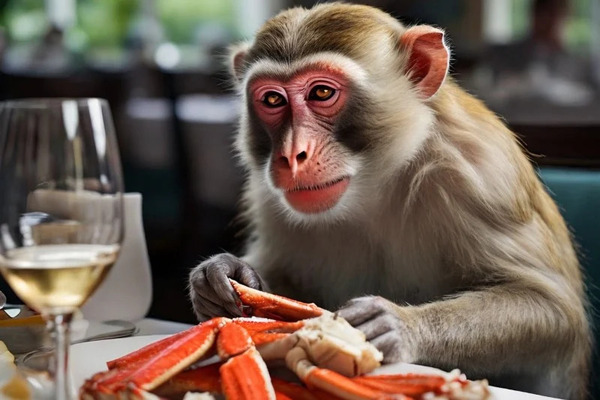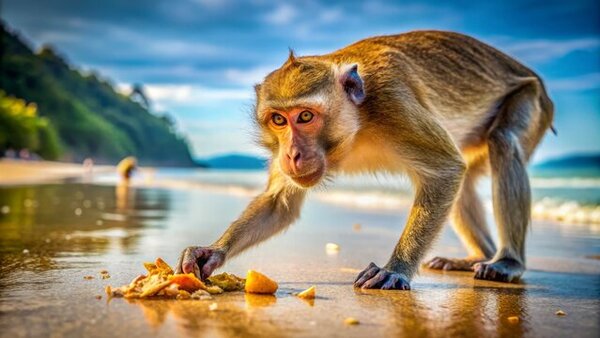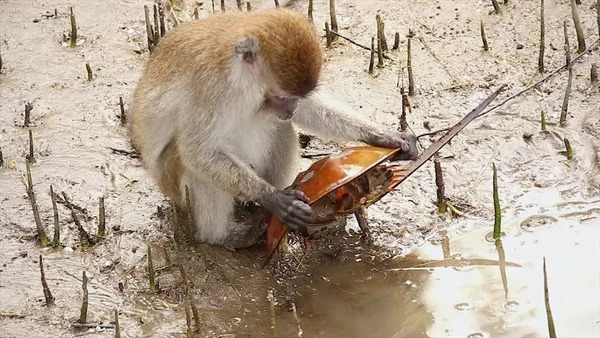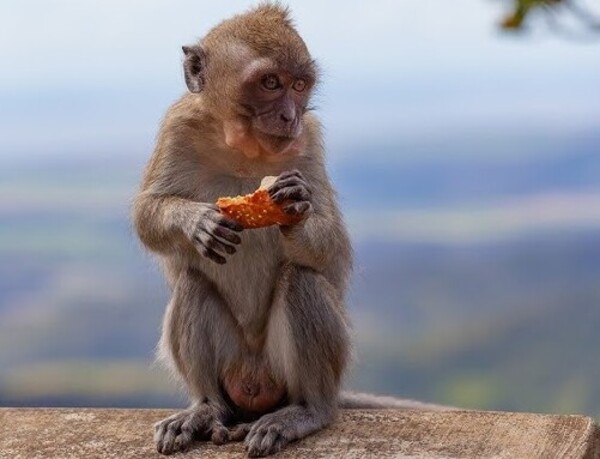The crab-eating monkey, also known as the rhesus macaque (Macaca mulatta), is a fascinating primate that inhabits various regions of Asia. In this article, we will explore the unique characteristics, habitat, diet, behavior, and conservation status of this remarkable species.

The term "crab-eating monkey" can be a bit misleading, as these monkeys don’t exclusively eat crabs. They are more commonly referred to as rhesus macaques, named after their association with the Rhesus factor in blood types. They are medium-sized monkeys, with males typically weighing between 14 to 20 pounds (6 to 9 kg) and females weighing slightly less.
Appearance: Crab-eating monkeys have a short, stocky body with a long tail. Their fur is usually brown or gray, and they have a pinkish face with expressive eyes.
Adaptations: Their physical traits make them well-suited for various environments, from urban areas to forests.
The lifespan of a crab-eating monkey, or rhesus macaque (Macaca mulatta), varies based on several factors, including habitat, diet, social structure, and environmental conditions. Here’s a detailed overview of their lifespan:
In the Wild: Rhesus macaques typically live around 15 to 20 years in their natural habitats. Factors such as predation, disease, food availability, and competition can affect their longevity in the wild.
In Captivity: When kept in controlled environments like zoos or research facilities, these monkeys can live significantly longer, often reaching up to 25 to 30 years. The improved conditions, regular veterinary care, and stable food supply contribute to their extended lifespan.
Diet: A well-balanced diet rich in fruits, vegetables, and protein can enhance health and longevity. In the wild, access to diverse food sources impacts their overall well-being.
Social Structure: Living in a stable social group can lead to reduced stress and better overall health. Social hierarchies and relationships within troops play a crucial role in their survival.
Health Care: In captivity, regular health check-ups and vaccinations help prevent diseases that can shorten their lifespan.
Predation and Threats: In the wild, threats from predators (such as large birds of prey or snakes) and human-related dangers (like habitat destruction or hunting) can significantly reduce their lifespan.
As crab-eating monkeys age, they may show signs of aging such as:
Changes in Fur: Their fur may turn gray or white, similar to aging in humans.
Physical Condition: Older monkeys may exhibit decreased mobility, dental issues, and changes in social behavior.
The lifespan of crab-eating monkeys is influenced by a combination of environmental factors, social dynamics, and access to healthcare. Understanding these factors can help in the conservation efforts and management of both wild and captive populations, ensuring that these fascinating primates live longer, healthier lives.

Crab-eating monkeys are primarily found in South Asia, including countries like India, Nepal, and Pakistan. They thrive in diverse habitats, such as:
Forests: They are commonly found in tropical and subtropical forests.
Urban Areas: Rhesus macaques are highly adaptable and often live in cities, scavenging for food.
Wetlands: They can also be found in marshy areas where they forage for aquatic food sources.
As their name suggests, crab-eating monkeys have a diverse diet that includes:
Fruits and Vegetables: They enjoy a variety of fruits, leaves, and vegetables.
Insects and Crustaceans: In some regions, they will eat insects and small crabs, particularly when other food sources are scarce.
Human Food: In urban areas, they are notorious for raiding garbage bins and stealing food from people, which has led to conflicts with humans.
Rhesus macaques are social eaters. They often forage in groups, which helps them find food more efficiently and offers protection from predators. Their opportunistic feeding habits enable them to thrive in various environments.
Crab-eating monkeys are highly social animals. They live in troops that can range from a few individuals to over a hundred. Their social structure is complex, with clear hierarchies and relationships.
Vocalizations: They use a variety of vocalizations to communicate with each other, including alarm calls, mating calls, and social interactions.
Body Language: Grooming is an essential aspect of their social life, helping to strengthen bonds and reduce tension within the troop.
Rhesus macaques are known for their intelligence. They can solve problems, use tools, and display a range of emotions. Their adaptability to urban environments showcases their ability to learn and thrive in changing circumstances.
The crab-eating monkey is currently classified as Least Concern by the International Union for Conservation of Nature (IUCN). However, they face several threats, including:
Habitat Loss: Deforestation and urbanization are shrinking their natural habitats.
Human-Wildlife Conflict: As they adapt to urban life, conflicts with humans can lead to culling or other negative outcomes.
Illegal Trade: Rhesus macaques are sometimes captured for the illegal pet trade or for research purposes.
Several organizations are working to protect the habitats of crab-eating monkeys and promote coexistence between humans and wildlife. Education and awareness programs are essential in reducing human-wildlife conflict and ensuring the survival of these fascinating primates.
The crab-eating monkey, or rhesus macaque, is a unique and adaptable primate that plays a vital role in its ecosystem. Understanding their behavior, diet, and social structure can help us appreciate these incredible animals and the challenges they face in a rapidly changing world. By supporting conservation efforts, we can contribute to the protection of the crab-eating monkey and its habitat, ensuring that future generations can enjoy this remarkable species.

The crab-eating monkey, or rhesus macaque, has become one of the significant threats to Florida’s ecosystems and human health. Originally native to Asia, these monkeys have established populations in Florida, primarily in areas like Silver Springs. Here’s a detailed overview of how they impact the environment and public health.
Ecological Disruption: Rhesus macaques are not indigenous to Florida, and their presence disrupts local ecosystems. As non-native species, they can outcompete native wildlife for resources, such as food and habitat.
Predation on Native Species: They may prey on native birds, small mammals, and other wildlife, which can lead to declines in those populations.
Urban Adaptation: Rhesus macaques are highly adaptable and have learned to thrive in urban environments. They often forage for food in residential areas, leading to increased human-wildlife interactions.
Social Structure: Living in large troops, these monkeys can cause significant disturbances in neighborhoods. Their behavior can lead to property damage, as they raid trash cans and invade homes in search of food.
Disease Transmission: Rhesus macaques can carry various zoonotic diseases, such as herpes simian virus, tuberculosis, and other pathogens. Their close interactions with humans increase the risk of disease transmission.
Bite Risks: Aggressive behavior can occur, particularly when monkeys feel threatened or when food is involved. Bites can lead to infections and may require medical attention.
Competition with Native Species: Rhesus macaques compete with native wildlife for food, particularly fruits and nuts. This competition can disrupt food chains and negatively affect local biodiversity.
Alteration of Plant Communities: Their feeding habits may lead to changes in plant communities, as they can overconsume certain plants, preventing regeneration and altering the natural landscape.
Population Control: Managing the population of crab-eating monkeys poses significant challenges. Their reproduction rates are high, making it difficult to reduce their numbers through traditional methods.
Public Attitudes: Residents often have mixed feelings about these monkeys. While some appreciate their presence, others see them as pests. This division complicates management efforts.
Balancing Act: Efforts to control crab-eating monkey populations must balance ecological integrity with ethical considerations regarding animal welfare.
Habitat Protection: Protecting native habitats and ecosystems is crucial for the long-term management of invasive species like the rhesus macaque.
The crab-eating monkey presents a multifaceted challenge for Florida’s ecosystems and public health. Their adaptability and social behavior have allowed them to thrive in an environment where they are not native, leading to ecological disruption and health risks for humans. Addressing these issues requires a comprehensive approach that includes public education, effective management strategies, and conservation efforts aimed at protecting Florida’s unique ecosystems.
The crab-eating monkey, or rhesus macaque (Macaca mulatta), can pose certain dangers to humans and ecosystems, especially in areas where they are not native. Here’s a detailed overview of the potential risks associated with these monkeys:
Aggression: Rhesus macaques can exhibit aggressive behavior, especially when they feel threatened, are protecting their young, or when food is involved. Their aggressive interactions can lead to bites or scratches, which may require medical attention.
Food Raiding: In urban areas, these monkeys often invade homes and businesses in search of food. They can cause damage by rummaging through trash, stealing food, and even breaking into homes. This behavior can lead to property damage and create frustration among residents.
Zoonotic Diseases: Rhesus macaques can carry various zoonotic diseases that may be transmitted to humans. These include:
Herpes simian virus (HSV): This virus can be dangerous and potentially fatal to humans.
Tuberculosis: Macaques can harbor strains of tuberculosis that may infect humans, especially those with weakened immune systems.
Bacterial Infections: Scratches and bites can introduce bacteria, leading to infections.
Public Health Concerns: The potential for disease transmission, especially in areas where humans and macaques frequently interact, raises significant public health concerns.
Invasive Species: In areas where they are not native, crab-eating monkeys can disrupt local ecosystems. They may compete with native wildlife for food and habitat, leading to declines in local species populations.
Overconsumption of Resources: Their feeding habits can lead to overconsumption of certain plants, which can alter plant communities and affect the broader ecosystem.
Boldness and Curiosity: Rhesus macaques are highly intelligent and curious animals. Their bold nature can lead them to approach humans closely, which can increase the likelihood of conflicts.
Learning from Experience: These monkeys are capable of learning behaviors from each other. If one monkey learns to raid a food source, others may quickly follow, leading to increased human interactions and potential dangers.
Population Control: Managing the population of crab-eating monkeys can be challenging. As they adapt to urban environments, traditional management strategies may be less effective, leading to ongoing conflicts.
Public Perception: The perception of these monkeys varies widely. While some people find them fascinating and enjoy their presence, others see them as pests. This division complicates management efforts and public policy.
While crab-eating monkeys are fascinating creatures, they can pose risks to human health and safety as well as to local ecosystems. Understanding these dangers is crucial for developing effective management strategies and ensuring safe coexistence between humans and these monkeys. Public education about proper interactions and the importance of protecting local wildlife can help mitigate conflicts and promote healthier ecosystems.

The robust chitinolytic activity of crab-eating monkeys (Macaca fascicularis) has garnered attention due to the presence of acidic chitinase in their digestive system. This enzyme plays a crucial role in breaking down chitin, a polysaccharide found in the exoskeletons of arthropods, including crabs. Here's a detailed overview of this enzyme's activity across various conditions:
Definition: Chitinase is an enzyme that catalyzes the hydrolysis of chitin into smaller oligosaccharides and eventually into N-acetylglucosamine.
Importance: This enzyme is essential for organisms that consume chitin-rich diets, allowing them to effectively utilize the nutrients contained in their food.
Origin: Crab-eating monkeys have evolved to consume a variety of foods, including crustaceans, which are high in chitin. Their digestive systems have adapted to efficiently process these substances.
Enzyme Characteristics: The acidic chitinase produced by these monkeys operates effectively in a lower pH environment, which is typical in the stomach where digestion begins.
Optimal Activity: Research indicates that the chitinase from crab-eating monkeys shows robust activity across a wide range of pH levels, which suggests its adaptability to different digestive environments.
Acidic Conditions: The enzyme demonstrates optimal activity in acidic conditions (pH around 4-5), aligning with the stomach’s natural acidity.
Alkaline Tolerance: Interestingly, it also retains significant activity in more neutral to slightly alkaline conditions, indicating a versatile function that might aid in digestion beyond the stomach.
Thermal Stability: The chitinase shows considerable robustness across various temperatures, suggesting it is well-suited for the fluctuating conditions encountered during digestion.
Optimal Temperature: The enzyme exhibits peak activity at moderate temperatures, typically around 37-42°C (98.6-107.6°F), which is conducive to the internal body temperature of the monkey.
Dietary Adaptation: The ability to effectively degrade chitin allows crab-eating monkeys to derive nutrients from chitin-rich foods, such as crabs and other arthropods, contributing to their dietary flexibility.
Nutrient Utilization: Efficient chitin degradation is essential for maximizing energy and nutrient intake from their diet, which is crucial for survival and reproductive success in their natural habitat.
Biotechnological Applications: Understanding the properties of crab-eating monkey chitinase can have implications in biotechnology, particularly in waste management and the development of biodegradable materials, as chitin and its derivatives are used in various industries.
Evolutionary Insight: Studying this enzyme offers insights into the evolutionary adaptations of primates to their diets and environments, highlighting the interplay between physiology and ecology
The robust chitinolytic activity of the crab-eating monkey's acidic chitinase under various pH and temperature conditions illustrates the remarkable adaptations of these primates to their environment. This enzyme not only plays a critical role in their digestive efficiency but also offers insights into potential biotechnological applications and evolutionary biology. Understanding such mechanisms can enhance our knowledge of primate biology and inform conservation efforts for these fascinating animals.
animal tags: Macaca-mulatta crab-eating-monkey
We created this article in conjunction with AI technology, then made sure it was fact-checked and edited by a Animals Top editor.